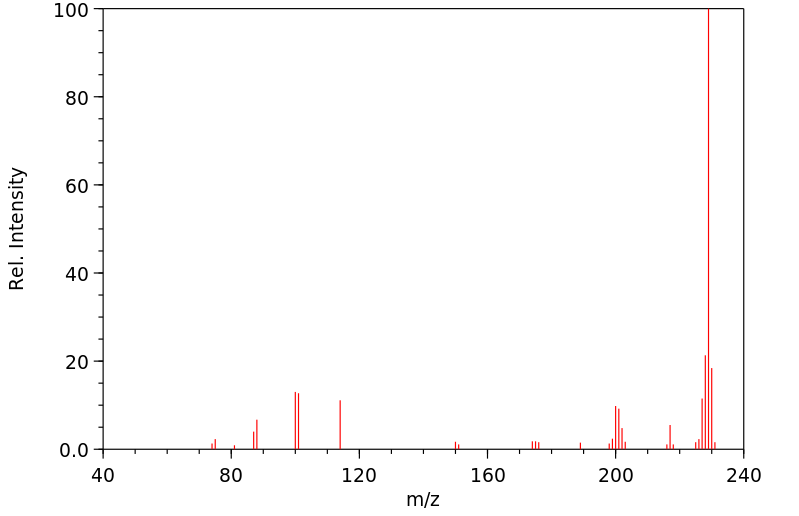naphtho[2,1-f]quinoline | 218-08-6
中文名称
——
中文别名
——
英文名称
naphtho[2,1-f]quinoline
英文别名
Naphtho<2,1-f>chinolin;1-azachrysene
CAS
218-08-6
化学式
C17H11N
mdl
——
分子量
229.281
InChiKey
ZKWHSGRDDNYNAN-UHFFFAOYSA-N
BEILSTEIN
——
EINECS
——
-
物化性质
-
计算性质
-
ADMET
-
安全信息
-
SDS
-
制备方法与用途
-
上下游信息
-
文献信息
-
表征谱图
-
同类化合物
-
相关功能分类
-
相关结构分类
物化性质
-
熔点:226-227 °C
-
沸点:449.7±14.0 °C(Predicted)
-
密度:1.239±0.06 g/cm3(Predicted)
-
保留指数:2556.9;407.31;407.18
计算性质
-
辛醇/水分配系数(LogP):4.8
-
重原子数:18
-
可旋转键数:0
-
环数:4.0
-
sp3杂化的碳原子比例:0.0
-
拓扑面积:12.9
-
氢给体数:0
-
氢受体数:1
安全信息
-
海关编码:2933990090
SDS
上下游信息
-
上游原料
中文名称 英文名称 CAS号 化学式 分子量 5-碘喹啉 5-iodoquinoline 1006-50-4 C9H6IN 255.058
反应信息
-
作为反应物:描述:naphtho[2,1-f]quinoline 在 乙醇 、 copper oxide-chromium oxide 作用下, 230.0 ℃ 、19.61 MPa 条件下, 生成 1,2,3,4,5,6-hexahydro-naphtho[2,1-f]quinoline参考文献:名称:STUDIES IN THE PHENANTHRENE SERIES. XIX. NAPHTHOQUINOLINES SYNTHESIZED FROM AMINOPHENANTHRENES*,1摘要:DOI:10.1021/jo01221a005
-
作为产物:描述:trans-1-(1-naphthyl)-2-(2-pyridyl)-ethylene 在 air 作用下, 以 甲苯 为溶剂, 反应 10.0h, 以13%的产率得到naphtho[2,1-f]quinoline参考文献:名称:多环氮杂芳烃的光化学环化脱氢路线摘要:本文报道了光化学环化脱氢制备多环氮杂芳烃的研究。从 2-、3- 和 4-[2-(1- 和 2-萘基)乙烯基]吡啶获得各种萘喹啉和萘异喹啉。4-[2-(3-菲基)乙烯基]吡啶得到芘[1,10-HIJ]异喹啉。描述了 (2-芳基乙烯基) 吡啶的有效制备方法。DOI:10.1055/s-2007-983745
文献信息
-
Regioselective Synthesis of Polycyclic and Heptagon-embedded Aromatic Compounds through a Versatile π-Extension of Aryl Halides作者:Wai Chung Fu、Zheng Wang、Wesley Ting Kwok Chan、Zhenyang Lin、Fuk Yee KwongDOI:10.1002/anie.201703551日期:2017.6.12halides, 2‐haloarylcarboxylic acids, and norbornadiene. The transformation is driven by the direction and subsequent decarboxylation of the carboxyl group, while norbornadiene serves as an ortho‐C−H activator and ethylene synthon via a retro‐Diels–Alder reaction. Comprehensive DFT calculations were performed to account for the catalytic intermediates.
-
Homologisierung der Fischer‐Indol‐Synthese: Chinoline via Homo‐Diaza‐Cope‐Umlagerung作者:Gabriela Guillermina Gerosa、Sebastian Armin Schwengers、Rajat Maji、Chandra Kanta De、Benjamin ListDOI:10.1002/ange.202005798日期:2020.11.9AbstractWir beschreiben eine neuartige Strategie zur Synthese von Chinolinen basierend auf einer Brønsted‐Säure‐induzierten Homo‐Diaza‐Cope‐Umlagerung von N‐Aryl‐N′‐Cyclopropylhydrazinen. Unsere Strategie kann als Homologisierung der klassischen Fischer‐Indol‐Synthese verstanden werden und ermöglicht die Bildung sechsgliedriger N‐Heterocyclen inklusive weiterer, vorher nicht zugänglicher Pyridinderivate
-
ORGANIC ELECTROLUMINESCENT DEVICE申请人:Merck Patent GmbH公开号:US20170077418A1公开(公告)日:2017-03-16The present invention relates to organic electroluminescent devices, the emitting layer thereof containing a blend of a luminescent material having a narrow singlet-triplet gap and a fluorescent emission material having high steric shielding.本发明涉及有机电致发光器件,其中发光层包含具有狭窄单重-三重能隙的发光材料和具有高立体屏蔽的荧光发射材料的混合物。
-
DNA‐induced circularly polarized luminescence of helicene racemates作者:Fuwei Gan、Peng Yang、Juncong Liang、Chengshuo Shen、Jeanne Crassous、Huibin QiuDOI:10.1002/chir.23566日期:2023.9luminescence (CPL) from helicene racemates via supramolecular association with DNA in aqueous solution. Racemic cationic helicene derivatives are immobilized in the grooves of commercially available double-stranded right-handed DNA, and the discrimination of left- and right-handed helicenes by chiral DNA is monitored by single molecule force spectroscopy. This subsequently leads to the generation of prominent
-
36. The synthesis of indenoquinolines作者:Neil Campbell、Arthur F. TempleDOI:10.1039/jr9570000207日期:——
表征谱图
-
氢谱1HNMR
-
质谱MS
-
碳谱13CNMR
-
红外IR
-
拉曼Raman
-
峰位数据
-
峰位匹配
-
表征信息
同类化合物
(S)-4-(叔丁基)-2-(喹啉-2-基)-4,5-二氢噁唑
(SP-4-1)-二氯双(喹啉)-钯
(E)-2-氰基-3-[5-(2,5-二氯苯基)呋喃-2-基]-N-喹啉-8-基丙-2-烯酰胺
(8α,9S)-(+)-9-氨基-七氢呋喃-6''-醇,值90%
(6,7-二甲氧基-4-(3,4,5-三甲氧基苯基)喹啉)
(1-羟基-5-硝基-8-氧代-8,8-dihydroquinolinium)
黄尿酸 8-甲基醚
麻保沙星EP杂质D
麻保沙星EP杂质B
麻保沙星EP杂质A
麦角腈甲磺酸盐
麦角腈
麦角灵
麦皮星酮
麦特氧特
高铁试剂
高氯酸3-苯基[1,3]噻唑并[3,2-f]5-氮杂菲-4-正离子
马波沙星EP杂质F
马波沙星
马来酸茚达特罗杂质
马来酸茚达特罗
马来酸维吖啶
马来酸来那替尼
马来酸四甲基铵
香草木宁碱
颜料红R-122
颜料红210
颜料红
顺式-苯并(f)喹啉-7,8-二醇-9,10-环氧化物
顺式-(alphaR)-N-(4-氯苯基)-4-(6-氟-4-喹啉基)-alpha-甲基环己烷乙酰胺
非那沙星
非那沙星
青花椒碱
青色素863
雷西莫特
隐花青
阿莫地喹-d10
阿莫地喹
阿莫吡喹N-氧化物
阿美帕利
阿米诺喹
阿立哌唑溴代杂质
阿立哌唑杂质B
阿立哌唑杂质38
阿立哌唑杂质1750
阿立哌唑杂质13
阿立哌唑杂质
阿立哌唑杂质
阿尔马尔
阿加曲班杂质43







